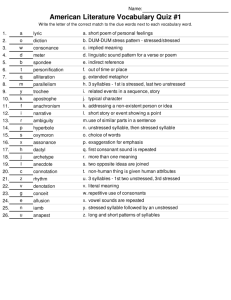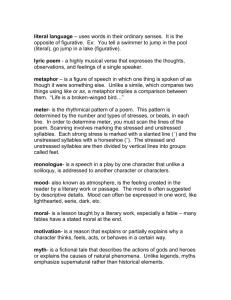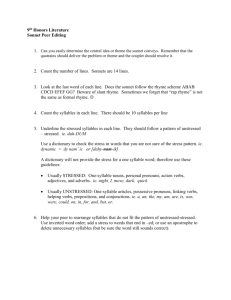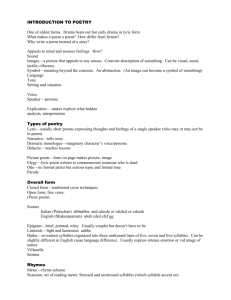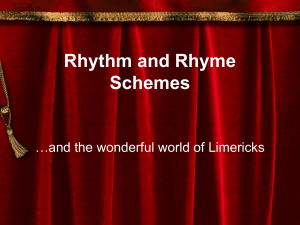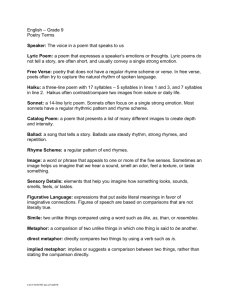poetry glossary
advertisement
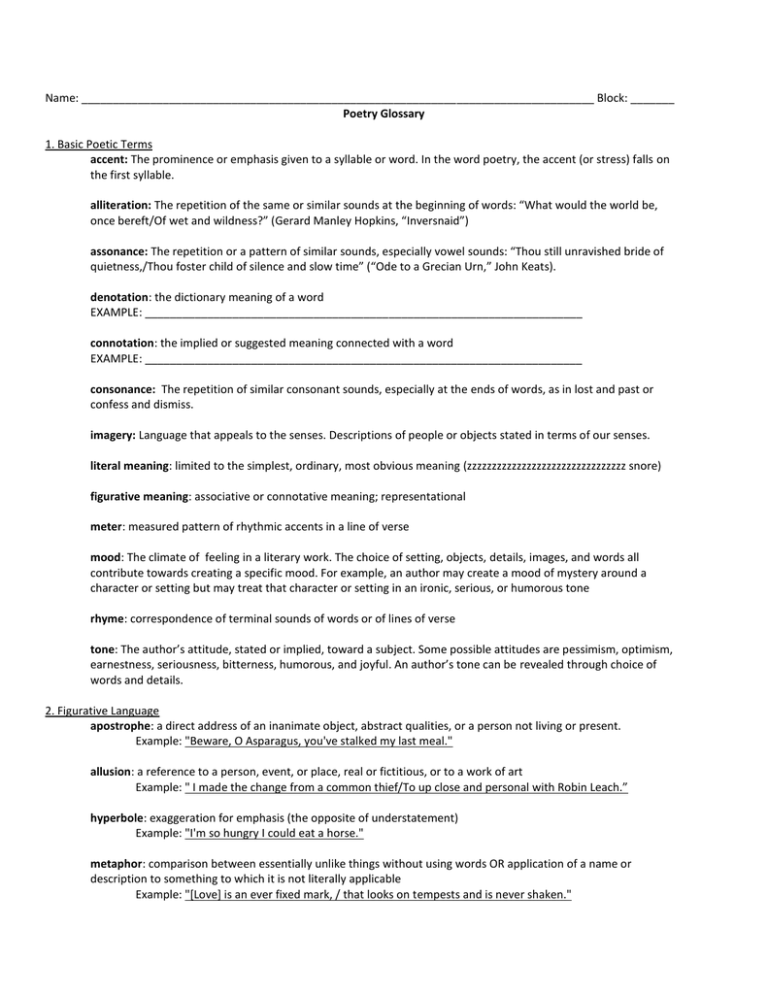
Name: __________________________________________________________________________________ Block: _______ Poetry Glossary 1. Basic Poetic Terms accent: The prominence or emphasis given to a syllable or word. In the word poetry, the accent (or stress) falls on the first syllable. alliteration: The repetition of the same or similar sounds at the beginning of words: “What would the world be, once bereft/Of wet and wildness?” (Gerard Manley Hopkins, “Inversnaid”) assonance: The repetition or a pattern of similar sounds, especially vowel sounds: “Thou still unravished bride of quietness,/Thou foster child of silence and slow time” (“Ode to a Grecian Urn,” John Keats). denotation: the dictionary meaning of a word EXAMPLE: ______________________________________________________________________ connotation: the implied or suggested meaning connected with a word EXAMPLE: ______________________________________________________________________ consonance: The repetition of similar consonant sounds, especially at the ends of words, as in lost and past or confess and dismiss. imagery: Language that appeals to the senses. Descriptions of people or objects stated in terms of our senses. literal meaning: limited to the simplest, ordinary, most obvious meaning (zzzzzzzzzzzzzzzzzzzzzzzzzzzzzzzz snore) figurative meaning: associative or connotative meaning; representational meter: measured pattern of rhythmic accents in a line of verse mood: The climate of feeling in a literary work. The choice of setting, objects, details, images, and words all contribute towards creating a specific mood. For example, an author may create a mood of mystery around a character or setting but may treat that character or setting in an ironic, serious, or humorous tone rhyme: correspondence of terminal sounds of words or of lines of verse tone: The author’s attitude, stated or implied, toward a subject. Some possible attitudes are pessimism, optimism, earnestness, seriousness, bitterness, humorous, and joyful. An author’s tone can be revealed through choice of words and details. 2. Figurative Language apostrophe: a direct address of an inanimate object, abstract qualities, or a person not living or present. Example: "Beware, O Asparagus, you've stalked my last meal." allusion: a reference to a person, event, or place, real or fictitious, or to a work of art Example: " I made the change from a common thief/To up close and personal with Robin Leach.” hyperbole: exaggeration for emphasis (the opposite of understatement) Example: "I'm so hungry I could eat a horse." metaphor: comparison between essentially unlike things without using words OR application of a name or description to something to which it is not literally applicable Example: "[Love] is an ever fixed mark, / that looks on tempests and is never shaken." oxymoron: a combination of two words that appear to contradict each other Example: bittersweet paradox: a situation or phrase that appears to be contradictory but which contains a truth worth considering Example: "In order to preserve peace, we must prepare for war." personification: the endowment of inanimate objects or abstract concepts with animate or living qualities Example: "Time let me play / and be golden in the mercy of his means" pun: play on words OR a humorous use of a single word or sound with two or more implied meanings; quibble Example: "They're called lessons . . . because they lessen from day to day." simile: comparison between two essentially unlike things using words such as "like," as," or "as though" Example: "My mistress' eyes are nothing like the sun" theme: A message, moral, or lesson conveyed through the events of a story or poem. Example: The theme of “We Wear the Mask” is that the act of masking can be both protective as well as reflective 3. Poetic Devices irony: a contradiction of expectation between what is said and what is meant (verbal irony) or what is expected in a particular circumstance or behavior (situational), or when a character speaks in ignorance of a situation known to the audience or other characters (situational) Example: "Time held me green and dying / Though I sang in my chains like the sea" imagery: word or sequence of words representing a sensory experience (visual, auditory, olfactory, tactile, and gustatory) Example: "bells knelling classes to a close" (auditory) symbol: an object or action that stands for something beyond itself Example: white = innocence, purity, hope alliteration: the repetition of consonant sounds, particularly at the beginning of words Example: ". . . like a wanderer white" assonance: the repetition of similar vowel sounds Example: "I rose and told him of my woe" elision: the omission of an unstressed vowel or syllable to preserve the meter of a line of poetry Example: "Th' expense of spirit in a waste of shame" onomatopoeia: the use of words to imitate the sounds they describe Example: "crack" or "whir" allusion: a reference to the person, event, or work outside the poem or literary piece Example: "Shining, it was Adam and maiden" rhyme: The occurrence of the same or similar sounds at the end of two or more words. When the rhyme occurs in a final stressed syllable, it is said to be masculine: cat/hat, desire/fire, observe/deserve. When the rhyme occurs in a final unstressed syllable, it is said to be feminine: longing/yearning. The pattern of rhyme in a stanza or poem is shown usually by using a different letter for each final sound. In a poem with an aabba rhyme scheme, the first, second, and fifth lines end in one sound, and the third and fourth lines end in another. 4. Poetic Forms open: poetic form free from regularity and consistency in elements such as rhyme, line length, and metrical form closed: poetic form subject to a fixed structure and pattern stanza: unit of a poem often repeated in the same form throughout a poem; a unit of poetic lines ("verse paragraph") blank verse: unrhymed iambic pentameter free verse: lines with no prescribed pattern or structure 5. Meter stress: greater amount of force used to pronounce one syllable over another pause: (caesura) a pause for a beat in the rhythm of the verse (often indicated by a line break or a mark of punctuation) foot: Two or more syllables that together make up the smallest unit of rhythm in a poem. In verse and poetry, meter is a recurring pattern of stressed (accented, or long) and unstressed (unaccented, or short) syllables in lines of a set length. For example, suppose a line contains ten syllables (set length) in which the first syllable is unstressed, the second is stressed, the third is unstressed, the fourth is stressed, and so on until the line reaches the tenth syllable. Each pair of unstressed and stressed syllables makes up a unit called a foot. The line contains five feet in all, as shown next: 1 2 3 4 5 Shall I..|..comPARE..|..theeTO..|..aSUM..|..mer’s DAY? Type of Foot Iamb (Iambic) Trochee (Trochaic) Spondee (Spondaic) Anapest (Anapestic) Dactyl (Dactylic) Syllable Pattern Number of Syllables Unstressed + Stressed Two Syllables Stressed + Unstressed Two Syllables Stressed + Stressed Two Syllables Unstressed + Unstressed + Stressed Three Syllables Stressed + Unstressed + Unstressed Three Syllables meter: The arrangement of a line of poetry by the number of syllables and the rhythm of accented (or stressed) syllables. The length of lines–and thus the meter–can also vary. Following are the types of meter and the line length: Monometer = One Foot Dimeter = Two Feet Trimeter = Three Feet Tetrameter = Four Feet Pentameter = Five Feet Hexameter = Six Feet Heptameter = Seven Feet Octameter = Eight Feet TAKE NOTES HERE:
